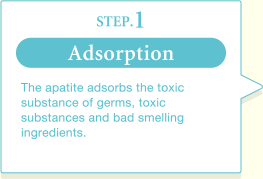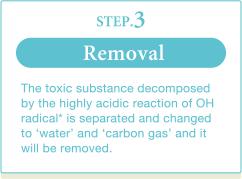
 The main ingredients of PROPRE are titanium dioxide and apatite.
The main ingredients of PROPRE are titanium dioxide and apatite.
-
“ Titanium dioxide ”
Cosmetics, cream for cakes, mayonnaise,
chocolate, etc. It is used in food that we eat that
contains additives. -
“ Apatite ”
It’s a well-known ingredient.
It’s the same main ingredient that is in the
toothpaste.

 The conventional anti-bacterial air refresher wraps the particles that are the causes of smells with a fragrance and removes the smell.PROPRE has an ability to decompose the particle itself by using the new photocatalyst technology. It decomposes the toxic substance in three steps and continues working for 24 hours.
The conventional anti-bacterial air refresher wraps the particles that are the causes of smells with a fragrance and removes the smell.PROPRE has an ability to decompose the particle itself by using the new photocatalyst technology. It decomposes the toxic substance in three steps and continues working for 24 hours.
*Acidic titanium = Additives / It is a semiconductor, the sterilizing and deodorizing abilities are demonstrated by the light energy.
*Apatite = Additives / It is used in toothpastes. It is excellent for adsorption.
*OH radical = It has a decomposition ability with organic matter and the best reaction with reactive oxygen.
PROPRE keeps working for 24 hours.
The lottery reaction will occur as the apatite adsorbs the
organic substance and the acidic titanium decomposes them
after that.It doesn’t waste unnecessary running cost and
continues working for 24 hours.
The effect of sodium hypochlorite will be halved after a
few weeks once it’s open.It has been about one year
since the product, PROPRE has been released.
The effect lasts for a few weeks from spraying.
 PROPRE has an ability to control the growth of bacteria continuously.
PROPRE has an ability to control the growth of bacteria continuously.
An egg that was just washed with water and an egg that was soaked in the chlorine antibacterial agent PROPRE for three minutes were prepared. Each egg was wiped on a petri dish and the photos are comparing the bacterial growth results, which were cultivated in an incubator at 35 degrees.
- For the case where an egg was only washed with water
- An egg after being soaked in the chlorine anti-bacterial agent for three minutes.
- An egg after being soaked in PROPRE for three minutes
- the long lasting effect of PROPRE can be seen.
 No odor
No odor
There's no uncomfortable chlorine type smell and the liquid has almost no smell.
No chlorine smell like in swimming pools after spraying.

 The major features are
The major features are
- There’s no smell.
- It stabilizes by way of decomposing bacteria and viruses.
- The effect is excellent compared to conventional products in its decomposition of
organic matter effect. - It’s gentle on the skin compared to alcohol and chlorine type products.
- It’s great in deodorizing cigarette smoke and urine smells.
- The performance will almost be the same after one year.
| PROPRE | Sodium hypochlorite water (chlorine type) |
Chlorine dioxide (chlorine type) |
Ethanol (Alcohol type) |
|
|---|---|---|---|---|
| Sterilizing ability |
Yes ●Decomposes bacteria and viruses into carbon dioxide and water eventually. ●The sterilization ability does not change even if the pH is changed. ●It can work for various kinds of bacteria. A large effect on norovirus, E coli., |
Yes ●It does not decompose bacteria and viruses. ●The sterilizing ability is weakened when it comes into contact with acid and alkali solutions. ●The pH level is high st 6±0.5 and it is said that it functions, however when coming into contact with acidic substances, chlorine gas will be generated and when coming into contact with alkali substances, a Kalki odor is caused and the stabilizing ability is weakened. |
Weak ●Not effective against norovirus, the flu and these certain viruses. |
|
| Resistant bacteria |
Doesn't occur Decomposes the bad smells and slime from the bacteria |
Can occur | Can occur ※There’s no chlorine added, so no chlorine type resistant virus, but it can be surmised that other resistant viruses will be generated. |
|
| Deodorizing ability |
Excellent in deodorizing regardless of pH (fast acting) |
Only deodorizes by pH (Neutralization by pH doesn’t remove the cause of the smell but loses volatility.) | Almost none There are quite a few aromatic ones in perfumes. |
|
| Sterilizing in the air |
Possible | Possible | Not possible ※It is possible with enough of it, however, there’s a possibility of causing a fire because the volatility is so strong. |
|
| Other | Smell free It can be used on metals and clothing materials, too. |
It has a particular smell. Must be careful of causing deterioration of metals and clothing materials |
There’s a particular smell. Need to be careful with flammable materials and high temperatures (dangerous depending on the place) |
|
| Retention period |
It can be retained for about one year. | The effect will be halved in about a few months. | It can be retained for about one year. | |

 This is the result of an antibacterial test.
This is the result of an antibacterial test.
| Microorganism | The number of bacteria(cfu/ml) | |||||
|---|---|---|---|---|---|---|
| Initial bacterial count | After five minutes | After one hour | After three hours | After six hours | After 24 hours | |
| E coli | 1.0×105 | 7.0×103 | <300 | <300 | <300 | <300 |
| Salmonella | 1.3×105 | 9.0×103 | <300 | <300 | <300 | <300 |
| Staphylococcus aureus | 1.1×105 | 7.6×104 | 1.0×103 | <300 | <300 | <300 |
※<300 (set at the minimum determination limit)
Test agency : Saitama Industrial Technology Center
 The cultivate inhibition ring is confirmed by using other bacterial liquid kinds.
The cultivate inhibition ring is confirmed by using other bacterial liquid kinds.
Each photo, on paper plates
Left : PROPRE added
Right: Peptone solution added
Halo : Cultivate inhibition ring, the area that looks transparent around the disk.
Test agency : Saitama Industrial Technology Center

 The norovirus cannot be cultivated actually, so feline calicivirus was used instead.
The norovirus cannot be cultivated actually, so feline calicivirus was used instead.
【Test outline】
Add and mix the suspension of the feline calicivirus and make the liquid to be tested.The infectivity of the virus liquid after 30 minutes and six hours at room temperature.Also,the pretest was conducted before and considered the test method of the virus infectivity.The feline calicivirus is largely used as an alternative virus to norovirus which cannot be cultivated.
| Test virus | Target | 1og TCID50/mL※1 | ||
| When started | after 30 minutes | after six hours | ||
| Feline calicivirus※2 | Specimen | 7.2 | 4.5 | <3.5 |
| Contrast | 7.2 | 7.2 | 7.0 | |
TCID50:median tissue culture infectious dose, Infected amount of 50% tissue culture
When started: Measure TCID50 of the contrast right after the action onset and set it as the start.
Contrast : Purified water
Operative temperature: Room temperature
<3.5:Not detected
Test agency : Japan Food Research Laboratories
※1 TCID50 logarithm value per 1 ml
※2 Alternative virus of norovirus

 Twice the sterilizing ability of chlorine.
Twice the sterilizing ability of chlorine.
| Oxidizing agent | PROPRE | Oxygen atom | Ozone | Hydrogen peroxide |
Sodium hypochlorite |
Chlorine |
|---|---|---|---|---|---|---|
| Relative potential | 2.05 | 1.78 | 1.52 | 1.30 | 1.10 | 1.00 |
| Acidic ability | 2.80 | 2.42 | 1.52 | 1.77 | 1.49 | 1.36 |

Test agency : Saitama Industrial Technology Center

 We have results of urine (ammonia) ,cigarettes (acetaldehyde) ,rotten eggs (hydrogen sulfide) and garlic (methyl mercaptan) smells being reduced.Each smell can be reduced by spraying in a smoking room, in a car, a public toilet and a pet’s toilet pad and so on.
We have results of urine (ammonia) ,cigarettes (acetaldehyde) ,rotten eggs (hydrogen sulfide) and garlic (methyl mercaptan) smells being reduced.Each smell can be reduced by spraying in a smoking room, in a car, a public toilet and a pet’s toilet pad and so on.
| Measured gas | Gas concentration(ppm) | |||||
| The initial concentration | After five minutes | After one hour |
After three hours |
After six hours |
After 24 hours |
|
| Ammonia smell | 72 | 8 | 0.5 or less | Not detected | Not detected | Not detected |
| Formaldehyde | 29 | 8 | 2 | 1.6 | 1.4 | 1.1 |
Test agency : Saitama Industrial Technology Center

 We apply the acute oral toxicity test with mice.
We apply the acute oral toxicity test with mice.

Individual customer
- Considering to sterilize places where children can touch
- Someone who is worried about norovirus
- Wantong to reduce a pet’s toilet pad smell safely
- Looking for an antibacterial agent with no smell
- Looking for an antibacterial agent that doesn’t cause rough skin
- Wanting to reduce the urine smell splashed on the toilet wall
- Wanting to reduce cigarette smells
Corporate customer
- Wanting to reduce ammonia smells in toilets and public facilities
- Wanting to control hygiene with smell free antibacterial agents on equipment in the kitchen
- Wanting to reduce smoke and toxic substances in smoking rooms at cafes and restaurants
- Wanting to try for effective sterilization against norovirus
- Wanting to reduce the smell of smoke in cars and rental cars
- Sterilization of equipment where sodium hypochlorite cannot be used
- Looking for antibacterial agents for walls, curtains and carpets.*With the minimum amount of color loss
- Looking for a product where the antibacterial deodorizing effect lasts long with a long retention period
- Looking for an antibacterial agent that is highly durable

 The effect will show up gradually after spraying. We do not recommend using this frequently in cleaning places.
The effect will show up gradually after spraying. We do not recommend using this frequently in cleaning places.
We recommend using this in places and for products where you can’t clean so easily that often.











